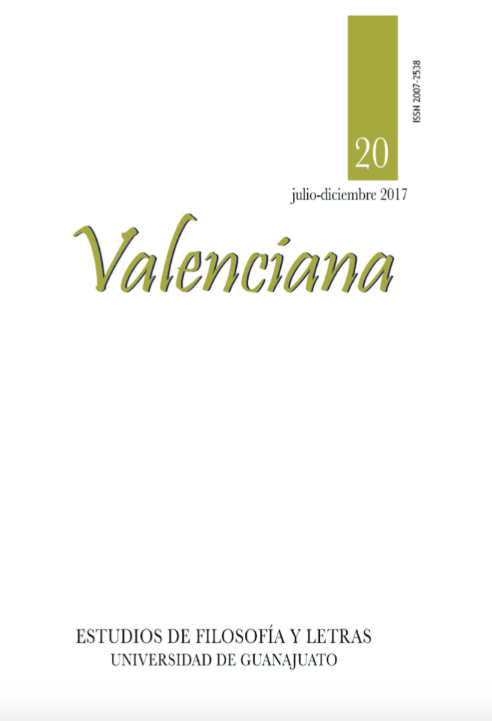The Cyborg Identity in the Narrative of Santiago Roncagliolo and Juan Cárdenas: the organic and the mechanical dichotomies in the construction of the body
DOI:
https://doi.org/10.15174/rv.v0i20.318Abstract
The primary goal of this article is the analysis of the novels Tan cerca de la vida (2010) by the Peruvian writer Santiago Roncagliolo and Ornamento (2015) by the Colombian writer Juan Cárdenas. We examine how both texts represent the disarticulation of the idea of man as a conjunction between the body and the soul, and show a subjective “twist” in a posthuman subject, as well registered in an aesthetic and cultural foundational dimension of a new realism and designed to unravel the foundational utopias of the Spanish-American Literature and the epistemological frames of the modernity.References
Aínsa, Fernando, 2012, Palabras nómadas. Nueva cartografía de la pertenencia, Iberoamericana-Vervuert, Madrid-Frankfurt, 220p.
Brown, Andrew e Ignacio M. Sánchez Prado, 2008, “Humanismo cyborg: el letrado posthumano en América Latina”, en Revista de Crítica Literaria Latinoamericana, núm. 68, año 34, Lima-Hanover NH, 2do semestre de 2008, pp.19-32.
Cárdenas, Juan, 2015, Ornamento, Periférica, Cáceres, 172p.
Escudero, Jesús Adrián, 2007, “El cuerpo y sus representaciones”, en Enrahonar, núm. 38/39, Bellaterra-Barcelona, pp. 141-157.
Guerrero Almagro, Berta, 2012, “La superación de lo carnal en ‘Tan cerca de la vida’: una aproximación al posthumanismo”, en Cartaphilus, vol. 10, Murcia, pp. 109-120.
Haraway, Donna J., 1991, “A Cyborg Manifesto: Science, Technology, and Socialist-Feminism in the Late Twentieth Century”, en Simians, Cyborgs, and Woman. The Reinvention of Nature, Routledge, New York-Milton Park, pp. 149-181.
Montfort, J.S. de, 2015, “Lo más importante es la educación”, en Revista electrónica Hermanocerdo, Web. .
Noguerol, Francisca, 2008, “Narrar sin fronteras”, en Entre lo local y lo global. La narrativa latinoamericana en el cambio de siglo (1990-2006), eds. Jesús Montoya Juárez y Ángel Esteban, Iberomaericana-Vervuert, Madrid-Frankfurt, pp. 19-33.
Quintana, Isabel, 2012, “Ficciones de lo (in)humano: biopolítica, ciencia-ficción y fantástico”, en Revista Iberoamericana, núms. 238-239, vol. 78, Pittsburgh, enero-junio, pp. 367-386.
Roncagliolo, Santiago, 2010, Tan cerca de la vida, Alfaguara, México, 336p.
Ventura, Lourdes, 2000, La tiranía de la belleza, pról. de José Antonio Marina, Plaza & Janés, Barcelona, 208p.
Vicini, Andrea y Agnes M. Brazal, 2015, “Longing for Transcendence: Cyborgs and Trans- and Posthumans”, Theological Studies, núm. 1, Vol. 76, marzo, pp.148–165.
Published
How to Cite
Issue
Section
License
Author(s) who publish in this journal do accept the next conditions:
According to copyright regulations, Valenciana does recognize and respect the authors’ moral right, as well as the right of property, which will be assigned to the journal for its diffusion in open access.
Valenciana does not charge authors for the submission, editorial process or publication in the journal.
All texts published and distributed by Valenciana (without exception) are supported by the license Creative Commons Attribution-NonCommercial 4.0 International (CC BY-NC 4.0), which allows third parties to use the publication as long as they mention the author and the first publication.
Authors can make other independent and additional contractual agreements for the non-exclusive use of his article published in Valenciana (e.g. including it in an institutional repository or in printed/electronic media), as long as it is explicitly clarified that the article was published for the first time in this journal.
For these purposes, authors must sign and send the letter of submission and copyright transfer form in a PDF file to this email address: revistavalenciana@gmail.com
This journal is under a license by Creative Commons Atribución-NoComercial-SinDerivadas 4.0 Internacional (CC BY-NC-ND 4.0)).











